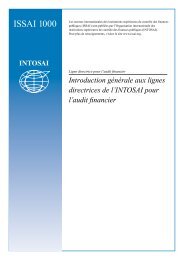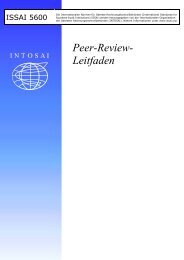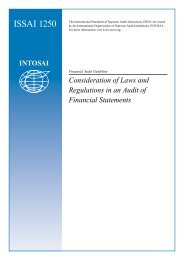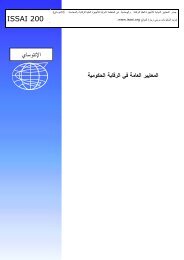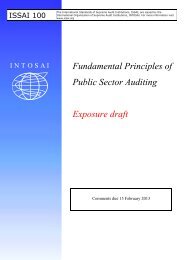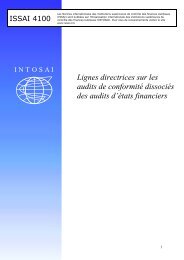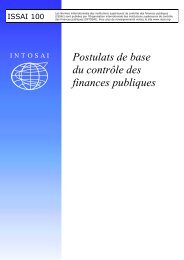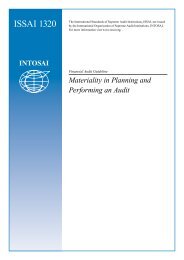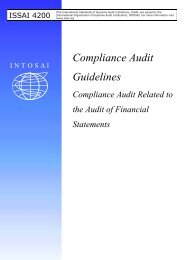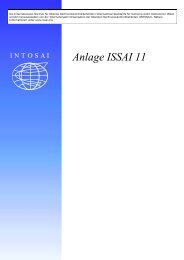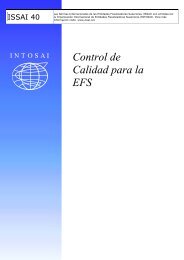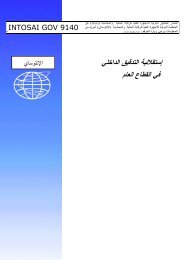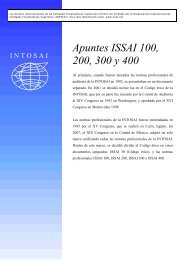ISSAI 1240
ISSAI 1240
ISSAI 1240
Create successful ePaper yourself
Turn your PDF publications into a flip-book with our unique Google optimized e-Paper software.
<strong>ISSAI</strong> <strong>1240</strong><br />
ISA 240<br />
THE AUDITOR’S RESPONSIBILITIES RELATING TO<br />
FRAUD IN AN AUDIT OF FINANCIAL STATEMENTS<br />
terms. In addition, the auditor might find it effective to<br />
supplement such external confirmations with inquiries of nonfinancial<br />
personnel in the entity regarding any changes in sales<br />
agreements and delivery terms.<br />
• The timing of substantive procedures may need to be modified. The<br />
auditor may conclude that performing substantive testing at or near the<br />
period end better addresses an assessed risk of material misstatement<br />
due to fraud. The auditor may conclude that, given the assessed risks of<br />
intentional misstatement or manipulation, audit procedures to extend<br />
audit conclusions from an interim date to the period end would not be<br />
effective. In contrast, because an intentional misstatement – for<br />
example, a misstatement involving improper revenue recognition – may<br />
have been initiated in an interim period, the auditor may elect to apply<br />
substantive procedures to transactions occurring earlier in or throughout<br />
the reporting period.<br />
• The extent of the procedures applied reflects the assessment of the risks<br />
of material misstatement due to fraud. For example, increasing sample<br />
sizes or performing analytical procedures at a more detailed level may<br />
be appropriate. Also, computer-assisted audit techniques may enable<br />
more extensive testing of electronic transactions and account files. Such<br />
techniques can be used to select sample transactions from key electronic<br />
files, to sort transactions with specific characteristics, or to test an entire<br />
population instead of a sample.<br />
A38. If the auditor identifies a risk of material misstatement due to fraud that affects<br />
inventory quantities, examining the entity’s inventory records may help to<br />
identify locations or items that require specific attention during or after the<br />
physical inventory count. Such a review may lead to a decision to observe<br />
inventory counts at certain locations on an unannounced basis or to conduct<br />
inventory counts at all locations on the same date.<br />
A39. The auditor may identify a risk of material misstatement due to fraud affecting<br />
a number of accounts and assertions. These may include asset valuation,<br />
estimates relating to specific transactions (such as acquisitions, restructurings,<br />
or disposals of a segment of the business), and other significant accrued<br />
liabilities (such as pension and other post-employment benefit obligations, or<br />
environmental remediation liabilities). The risk may also relate to significant<br />
changes in assumptions relating to recurring estimates. Information gathered<br />
through obtaining an understanding of the entity and its environment may<br />
assist the auditor in evaluating the reasonableness of such management<br />
estimates and underlying judgments and assumptions. A retrospective review<br />
of similar management judgments and assumptions applied in prior periods<br />
may also provide insight about the reasonableness of judgments and<br />
assumptions supporting management estimates.<br />
25<br />
260 The Auditor’s Responsibilities Relating to Fraud in an Audit of Financial Statements



